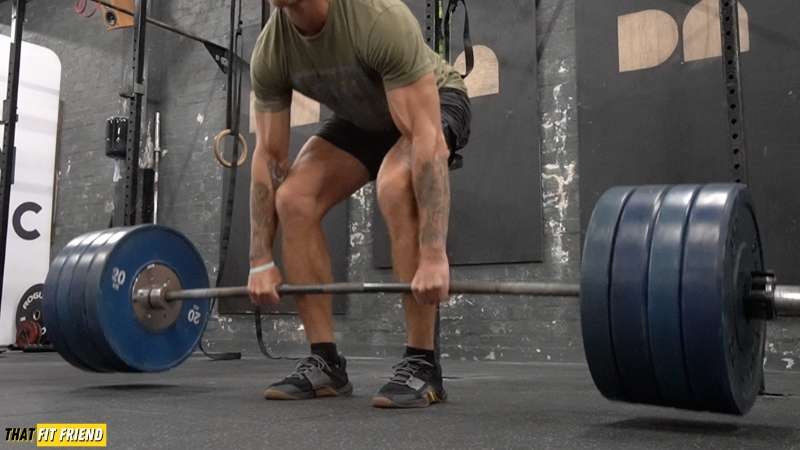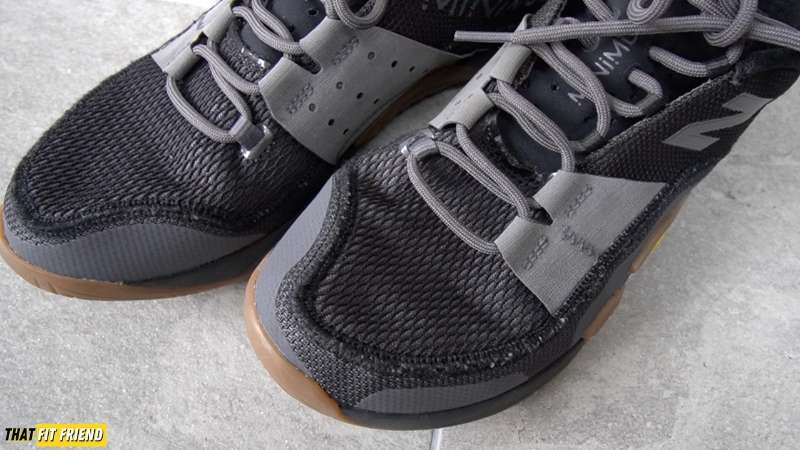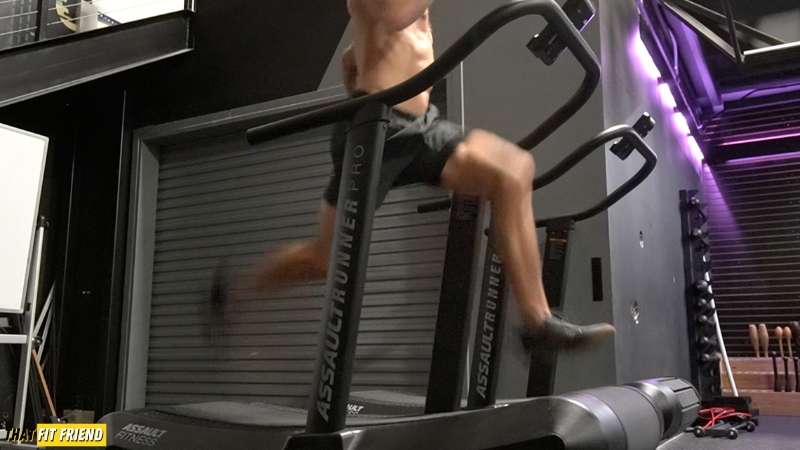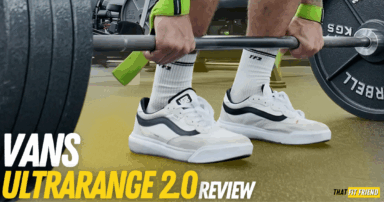That Fit Friend is supported by its readers. I [Jake Boly] run this site myself and buy the gear I review. If you purchase through my site, I may earn commissions on sales, read more here!
The New Balance Minimus TR V2 has been a letdown, to put it bluntly. And I don’t say that because this shoe is inherently “bad” in the gym, but it’s more so focused on what the Minimus training shoe line could be.
New Balance, come on, bring back the older Minimus design. We all miss it and want it back—read the comments on my YouTube video. Moving past my own personal complaining, the Minimus TR V2 has been objectively an okay shoe in the gym.
For lifting, CrossFit, and cross-training this model has held its own for the most part. It’s stable for lifting and has a nice degree of articulation for moving with the feet.
It’s not all sunshine and rainbows, though. For example, if you’re thinking about this shoe because it’s “wide” or mimics the older Minimus, I’d pump your breaks and take a step back because it’s going to be a miss for most in these contexts, imo.
Minimus TR V2 Specs to Know
For this review, I bought the Minimus TR V2 (2E) option because I wanted to compare what New Balance’s “wide” feels like compared to their other wider shoes and different companies’ models.
- Price: $119.99
- Heel-to-Toe Drop: 4mm
- Weight: 10.45 oz (size 10 model)
- Removable Insole: No
- Width: Medium/2E Options
- Narrower Feet Sizing: True to Size
- Wider Feet Sizing: Go up a half size (even in the 2E option)
- Good Alternative: Born Primitive Savage 1
What I Like/Pros
1. Midsole is stable for heavier training
I was curious to see how the FuelCell midsole would perform in this shoe regarding stability, but it’s been solid thus far. I’ve deadlifted over 455 lbs in this shoe and have done heavy dumbbell lunges (90s in each hand) and this shoe’s midsole has done well.
For cross-training, this midsole is also pliable to make it comfortable and bouncy. I never felt like this shoe felt like a cinderblock when jumping and bounding, and I do think this shoe has a nice athletic performance when it comes to its midsole’s feel and construction.
2. Better midfoot construction
I don’t know if you ever used the New Balance TR or TR BOA for rope climbing, but they were brutal, especially when discussing long-term durability. The midfoot on both of my models broke from rope climbing abrasion and that was after a relatively low amount of climbs (under 30).
The reworked midfoot in this model is solid and it’s held up so far to my rope climbing workouts. I know rope climbing is a tiny subset of most CrossFit WODs, however, it’s nice knowing this shoe isn’t going to break right away on you like the last two iterations.
3. Has a low-profile and sock-like fit
If you love training and even barefoot shoes that have a lower profile and sock-like fit on the foot, then you’ll resonate with this model. It’s similar to the last two Miniumus models in this context and hugs the foot well.
For my friends who like lighter shoes that feel like socks, you’ll enjoy this model. In a world of training shoes that keep moving towards trainers being more chunky, this is one area where I think the Minimus carves out a category of its own.
What I Don’t Like/Cons
1. Open stitching around the toe box
What’s that about? Mine is already starting to fray and look fuzzy, and that’s after a few weeks of training, including things like burpees and rope climbs, which are notorious for their upper abrasion. Not my favorite feature of this model.
I’d also keep this in mind if you do a lot of outdoor training where you may have a little more concrete rub. For example, I like to do prone-to-sprint drills here and there, and these would be the LAST shoes I use for those because of this stitching.
2. The toe box isn’t that wide
I feel like this shoe’s toe box is a letdown when we’re talking about wide training shoes. There’s a taper at the end of the toe box and it’s noticeably narrower compared to the older Minimus models.
Granted, this shoe is wider than the super narrow-fitting Minimus TR and TR BOA, but still, it’s pretty snug and I found my toe jamming into the end of the toe box. If you have wider feet (I have E/EE width feet), I’d go up a half-size if you’re still wanting to try this model out.
3. Heel construction is straight ugly (Sorry, had to be said)
From a purely aesthetic [and I guess functionality?] context, the heel in this model is super unattractive. The heel juts out and I’m not exactly sure why so many shoe companies keep putting these grandiose and chunky heels on training shoes.
Is it for lifting? I can assure you that this model would feel just as stable without the heel jutting out. If it’s for handstand push-ups then I feel like it’s also a miss and could have lipping issues down the road based on how it’s built. Why not just put a light layer of TPU on the back without creating a weird step-like heel?
4. No longer a zero-drop shoe
A countrpoint to the above pro. If you loved the Minimus for its 0mm heel-to-toe drop, then you’re going to be really sad to learn this model has moved to a 4mm heel-to-toe drop. Personally, I do think this gives this shoe more range regarding movement mechanics for a wider clientele.
However, the 0mm heel-to-toe drop is what made the Minimus great in its own product category. There aren’t many 0mm heel-to-toe drop training shoes to choose from and if you love training in a flat trainer then your options just got more limited.
Performance Breakdown
My Experiences Lifting In This Shoe
This shoe’s midsole is built with New Balance’s FuelCell foam. In the context of other training shoes, this material is also used in the FuelCell models which are more oriented towards HIIT and class workouts.
I’ve always loved the Minimus stability for lifting so I pushed this shoe in multiple exercises. Of note, some of my heaviest sets included a set of deadlifts at 455 lbs for five, leg pressing 550 lbs, and hitting heavy single-leg lunges.
In all of these exercises, this shoe performed exceptionally well and I never felt like balance was compromised due to the midsole compressing. I would prefer less toe spring in this shoe when deadlifting but it’s not so aggressive to where most lifters will be massively impacted by it, in my opinion.
The outsole and sole also feel well into this shoe’s performance for lifting. The break at the forefoot gives you additional mobility when flexing through the toes doing dynamic lifts and the rubber tread grips different surfaces well.
If you’re a lifter who trains on different surfaces then you shouldn’t have issues with grip in this model. I also think you’ll enjoy this shoe for lifting if you’re big on shoes that once again have a sock-like fit with a bias toward flexibility.
Using This Shoe for CrossFit WODs and Cross-Training
I used WODs as conditioning and this shoe has performed well regarding stability and versatility for all of the workouts and tasks I’ve thrown at them. For box jumps and double-unders/jump rope, they’re bouncy and light so they don’t feel overly bearing on the feet.
The outsole and midsole also perform well for WODs where you’re blending heavier strength work with dynamic work. For example, if you’re hitting heavier squats into kettlebell exercises then you’ll enjoy this shoe’s dynamic feeling in the gym.
Something I found funny with this shoe’s CrossFit performance is that New Balance beefed up this shoe’s midfoot to prolong durability, but then added exposed stitching around the toe box. The midfoot is more durable, but now the toe box gives me pause for certain exercises.
After a few conditioning sessions where I was doing burpees on rubber gym floors I was starting to have my stitching get fuzzy. I’m curious how long it will last for others before ripping and splitting. I said it once and I said it again, what’s the point of this construction element?
For cross-training, I like the Minimus TR V2. They have a nice athletic feel to them and this is where their sock-like fit and lighter weight really excel, in my opinion.
These felts are great for multi-directional exercises and explosive movements like broad jumps and skater strides. The upper security is strong enough to prevent spillover and the articulation works well for forefoot-heavy training.
If this shoe’s last fits your foot anatomy and you understand the changes made to this shoe then I do think you’ll enjoy them for cross-training and CrossFit contexts, I’d just suggest being conscious of the toe box durability for CrossFit-focused sessions.
Doing Short Runs and Walking In This Shoe
For short runs, this shoe has been okay. I’ve preferred them most for sprints and short intervals that range from 400-800 meters. These run denser so for short runs, they should be good enough regarding overall comfort.
I’ve been a big fan of them for sprints specifically due to their minimalist feel and FuelCell midsole. They feel athletic, which I love, especially when ripping sprints on a curved treadmill.
For runs longer than 1-2 miles, I’d pass on this shoe unless you generally like denser midsoles or you’re used to running with minimalist shoes. I think this model will be uncomfortable for most in this context, though.
On a daily wear basis, I’m hot and cold on this shoe. In theory, I think I would like them if their fit was a little better. More specifically, because I find this shoe to run a little short I find the toe box to feel limiting and uncomfortable.
I’ve worn these for walking the pup 3-miles and for a few full days of travel and I’ve been far from impressed. Wearing these in the airport and all day made me longing for my Haze Trainers which are typically my go-to travel training shoes.
Construction Details
Midsole
- New Balance FuelCell foam runs throughout and there’s a relatively low stack height used in this shoe.
- There’s a fair amount of toe spring in this model, which gives the forefoot a more athletic feel but can take away from having a “flatter” feeling.
- The midsole at the heel juts out and there’s a TPU/rubber overlay to promote slide when doing handstand push-ups.
Outsole
- Full rubber outsole with a small break at the forefoot to promote more flexibility and articulation.
- Herringbone tread at the forefoot and heel with a rigid pointed midfoot outsole pattern.
- Increased medial and lateral midfoot wrap for increased durability and support for rope climbs.
Upper
- Mesh and textile upper with synthetic overlays around the toe box and midfoot.
- Rubber-esque material protects the midfoot from abrasion while increasing overall grip.
- Lightly padded heel and boot which promotes comfort and overall lockdown.
Laces and Tongue
- Wide foam tongue that has a lot of stretch and give. It’s not gusseted, and it really should be to promote overall security.
- Five core loop eyelets with round laces.
Closing Thoughts, Would I Buy Them Again?
Probably not.
I like the idea behind these shoes and I’ve always held a special place in my heart for the niche characteristics the New Balance Minimus delivers on, but I feel like there are oversights on this shoe.
For example, I don’t have a ton of faults with this shoe’s performance — and don’t get me wrong — for most, these will work in the gym for most lifting and cross-training asks.
My hang-ups revolve around the fact that the older Minimus models were so much better, the fact that they [NB] moved away from a zero-drop construction and the open stitching at the toe box.
What Would I Buy Instead?
- Adidas Dropset Trainer 2 or 3: If your main asks revolve around lifting with some cross-training.
- Haze Trainer or RAD ONE: If your asks are comfort, CrossFit, and aesthetics.
- Born Primitive Savage 1: If you want a wide shoe for doing everything with a 4mm heel-to-toe drop.
If you have additional questions about the Minimus TR V2, drop a comment below or hit me up on Instagram!




















Add a Comment